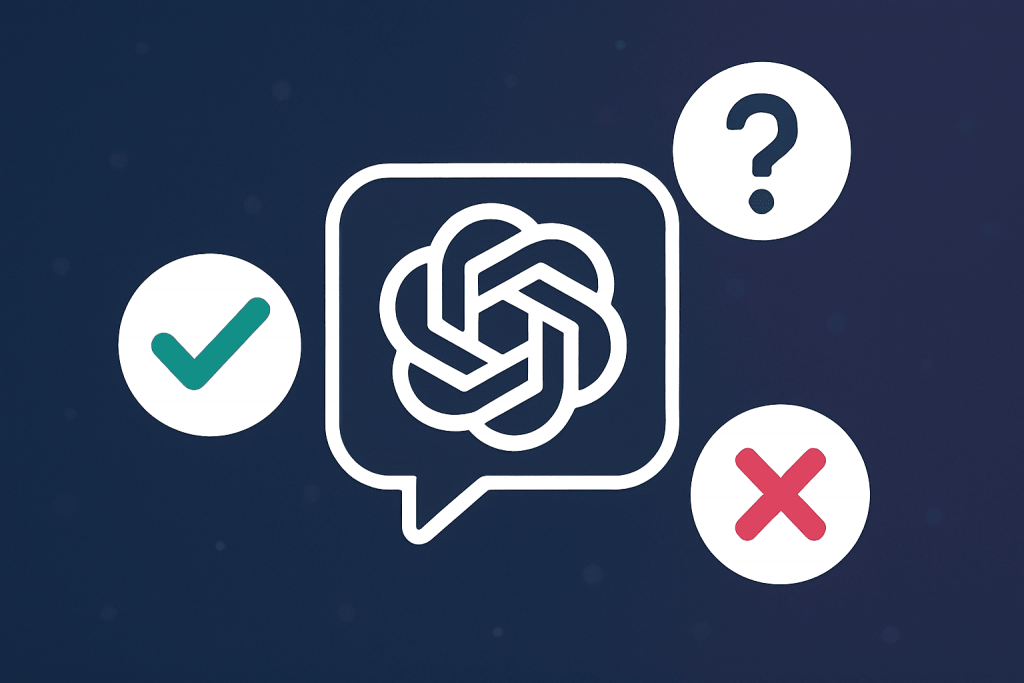
ChatGPT is a powerful tool that generates text-based answers from a vast dataset, but it is not a database of facts. It produces plausibly sounding responses (answers that seem convincing and logical, even if they may be inaccurate or fabricated) by relying on language patterns. This means that even when answers sound confident, they may still be false or incomplete. Reviews show that the model can make mistakes in simple questions and continue making them even after corrections. This means its conclusions should be treated as suggestions rather than absolute truth. That is why it is important for users to follow safety rules and verify the information.
Risks of Using ChatGPT
- Disclosure of personal data. The service is not intended for handling confidential information. Researchers recommend avoiding the transfer of passwords, financial data, or other sensitive details in chat. Free and personal accounts may use your queries to further train the model.
- Incorrect or fabricated information. ChatGPT has no direct access to live databases, and its answers are based on training data collected up to a certain date (in earlier versions — roughly until 2021). In newer versions, the model can access more recent data and even connect to the web for up-to-date information. However, even in such cases, “hallucinations” are possible — false facts, invented sources, or fake links. That is why it is always worth checking content against trusted sources.
- Fake sources and links. Even when the model provides citations or references, they often do not exist or contain errors. Blindly trusting such links can be dangerous.
- Lack of ethical filtering. Without filtering, the model may generate biased or offensive content. This is why organizations should implement moderation mechanisms.
To reduce the risk of errors, it is useful to cross-check information with official resources and verified websites. On RX-NAME you can find tips and services that help navigate the world of domains and digital tools more effectively.
Rules for Safe Use
For safe and comfortable use of ChatGPT, it is worth following several basic rules. These recommendations are based on advice from researchers and security practitioners:
- Use official services. Make sure you are interacting through a legitimate OpenAI interface; avoid unauthorized websites or fake apps.
- Do not share confidential information. Do not enter passwords, banking details, or other personal data. ChatGPT is not a secure channel for exchanging sensitive information. A practical tip: never share anything you would not want to appear publicly.
- Avoid third-party accounts. Cybersecurity experts recommend not registering via Google or Facebook to prevent additional data-sharing channels; instead, create a separate password and enable two-factor authentication.
- Use secure connections. Sensitive information should only be transmitted through encrypted channels. Make sure the URL starts with https; this protects your data from outsiders.
- Control access. Organizations should restrict access to services, granting permissions only to authorized individuals, performing regular audits, and monitoring plugin security. Some experts also advise implementing the “zero trust” principle (Zero Trust), which requires verifying every user and device.
- Be mindful of licenses. The model can generate text that infringes copyright. Before publishing, check whether the material contains protected fragments.
ChatGPT does not run on your computer but on powerful remote servers. When you enter a query, it is sent through the internet to cloud infrastructure, where the model performs complex computations and generates a response. This server-side processing ensures speed, stability, and the ability to serve millions of users simultaneously.
It is important to understand that all the data you input is also processed on these servers. This means information does not remain locally only on your device. Although the service provider implements protective measures, it is impossible to completely eliminate the risk of data access.
That is why you should not enter personal data, passwords, card numbers, or any other confidential information in the chat. By using ChatGPT for ideas, drafts, or explanations, you maintain a balance: you benefit from modern technology without exposing yourself to unnecessary risks.
How to Verify Information
Understanding the limitations of artificial intelligence helps to use its answers correctly. Here are some tips on how to verify information:
- Cross-check with multiple sources. Librarians recommend verifying statements with different authoritative resources: scientific articles, official reports, news outlets, and expert opinions. If several credible sources confirm a fact, it is likely reliable.
- Assess authority. Determine who the source’s author is. Information from recognized institutions, research centers, or specialists carries more weight. Pay attention to website reputation: educational domains (.edu), government sites (.gov), and organizations (.org) are often more reliable.
- Analyze the evidence. Check whether the text includes references to scientific research and data. Reliable information is built on verified evidence, not assumptions.
- Consider relevance and context. The publication date always matters: in older ChatGPT versions, the knowledge base was limited to data up to about 2021, while newer models are trained on later material and may use web access for fresher facts. In any case, it is important to evaluate whether the information fits your request, whether context is missing, and whether it is confirmed by trusted sources.
- Detect bias. Try to determine whether sources may have their own interests or ideological perspectives. Researchers recommend considering different viewpoints and selecting balanced ones.
- Check citations and references. If the model provides sources, verify whether they actually exist. Use library catalogs or search engines to confirm that titles, authors, and dates match. ChatGPT may invent article titles or misattribute authors.
- Practice “lateral reading.” Experts suggest not relying solely on how a site looks or its design; instead, open several independent sources and compare the information. This approach helps detect inaccuracies and bias.
Despite its limitations, artificial intelligence remains a useful assistant when used wisely. It works well for explaining basic concepts, generating ideas for research or text structure, and quickly drafting content. You can also ask it to give feedback on your text or suggest alternative phrasing. However, it should not be used as the only source of facts or relied upon for academic or legal conclusions. When working with the information you receive, it is crucial to apply critical thinking, verify data using authoritative sources, and evaluate its accuracy. Only such an approach allows you to benefit from AI while maintaining your safety and information hygiene.

Leave a Reply